
Product test
Huawei P40 Pro review: would, should and could be the best, if...
by Dominik Bärlocher

The Huawei P40 Pro+ is even better than the P40 Pro. For 400 francs more, you get an extra camera and an exchanged camera. What does this mean in everyday life? Where and in what situations does the camera perform well?
Just a few weeks after the release of the Huawei P40 Pro, the Huawei P40 Pro+ follows. At first glance, the phones don't differ much from each other. One only comes in black and white, the other in all sorts of colours. One is 9 millimetres thick, the other just 8.95. One costs nearly 1,000 francs, the other almost 1,400. Neither is equipped with Google services.
The P40 Pro+ is a device that raises questions. It costs more, so it should be better. If the P40 Pro is already supposed to be the pinnacle of technology, what could beat it? The best of the best? Or is this a harbinger of things to come? A massive camera software upgrade that justifies an extra CHF 400? Wouldn't it make more sense to release the software and the phone at the same time? And amid all the hubbub: what's the P40 Pro up to?
First of all, I'd like to express my scepticism about this Pro Plus business. The Pro+ makes the Huawei series look rather strange and leads us to strongly suspect that the manufacturer just wants to lighten our wallets a bit more.
I was sceptical about the whole Pro thing at the time. However, the manufacturers Pro models have become a worthwhile upgrade over the non Pro models. Now Pro is supposed to be the new non-Pro and the Plus or Ultra versions are supposed to be even more Pro than Pro. In the meantime, I'm strongly pro Pro, because these devices simply deliver more. Yes, they cost more, but the difference between the base version and the Pro is noticeable, especially with Huawei.
So let's move on to the 'Plus'. This makes the P series portfolio extremely confusing. Before, this is what the ascending order of performance and price looked like at Huawei:
That wasn't enough and Huawei said to itself, "Let's put an end to this logical system". Now the order looks like this:
OK. Let's see: if the idea was disruptive marketing, it clearly didn't work. It's fine to want to disrupt, but the whole thing has to be clear and understandable. If even the experts on the scene don't know exactly what it is, then the concept definitely lacks logic.
When it comes to the hardware, you have to look for the differences between the two models. I'll make it easy for you:
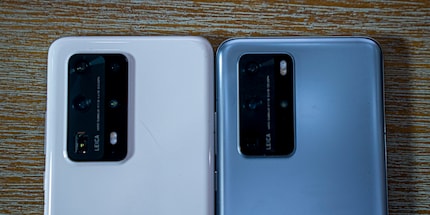
| Huawei P40 Pro | Huawei P40 Pro+ | |
|---|---|---|
| Poids sans carte SIM ou mémoire | 209 g | 226 g |
| Mémoire interne « ROM » | 256 Go | 512 Go |
| Caméra principale (identique) | Capteur Ultra Vision 50 MP (Grand Angle, f/1.9 aperture, OIS) | Capteur Ultra Vision 50 MP (Grand Angle, f/1.9 aperture, OIS) |
| Capteur ultra grand angle (identique) | Capteur cinématographique de 40 MP (Ultra Grand Angle, f/1.8) | Capteur cinématographique de 40 MP (Ultra Grand Angle, f/1.8) |
| Capteur téléphoto | capteur téléphoto SuperSensing de 12 MP (f/3.4, OIS) | Capteur téléphoto 8 MP (zoom optique 3x, f/2.4, OIS) |
| Capteur Zoom | Aucune | Capteur SuperZoom 8 MP (zoom optique 10x, f/4.4, OIS) |
| Capteur de profondeur | Capteur 3D à détection de profondeur | Capteur 3D à détection de profondeur |
| Chargeur | max 40 Watts | max 65 Watts |
It all revolves mainly around the camera. That is, around the zoom of the P40 Pro and the zooms of the P40 Pro+. While the P40 has one zoom lens, the Plus has two. In addition to a smaller sensor, the Plus has a larger optical zoom. The aperture is also lower. This means that the Plus will let more light into the lens. In simple terms: better depth of field and better night shots. Maybe?
All the photos in this article have been taken in a way that leaves as many decisions as possible to the phone's artificial intelligence (AI). I want to see what the phone can do, not what the best possible photo should look like. Because when Huawei and co are frothing at the mouth with AI and priding themselves on the computer's ability to think, then I let the computer think and see what the machine suggests.
Also, the two phones don't run on the same version of EMUI.
This means that the AI can react differently under the same conditions. This becomes very noticeable when testing the microphone in the video. It would appear that the filter for differentiating background noise such as wind from dialogue has been improved. As the non-commercial version of the P40 Pro+ software does not have a change log, the claim is difficult to prove.
One of my favourite features of the P40 Pro's camera is the 50-megapixel recording. This is also available on the P40 Pro+, but with an additional AI mode. All the photos in this camera test can be downloaded and viewed at full size on your PC or Mac. I had to compress them a bit for our system.


Fascinating! Great. Twice the same image. Except in one picture, the camera took three seconds and the AI took the picture exactly like the camera without the AI. The AI image is only 8.85 MB, while the non-AI image is 11.2 MB. The EXIF data for the AI image indicates that the exposure time is 0.009712 seconds, while for the normal image it is 0.009603 seconds. To use a traditional photography unit of measurement, both are at about 1/1000.
This is just a first look. At second glance, you can see what the 50MP AI mode does. The stone in the left foreground is a little more detailed in the AI photo.
This is a first look.


Four hundred francs. That's right. So far, it's absolutely not worth it. Sure, it's a cool little gadget yes, but it's really not worth the extra.
The lower the aperture of a lens, the more light it lets through to reach the sensor behind it. Huawei not only exploits this in hardware, but has also integrated the aperture mode in software. As a user, you can manually set the aperture to f/0.95, allowing for some pretty spectacular night shots that don't look as contrived as those in night mode. You can also use it to push the depth of field to the extreme and create a spectacular blur.
So I set up my GorillaPod tripod on a bridge at night and took the following photos.

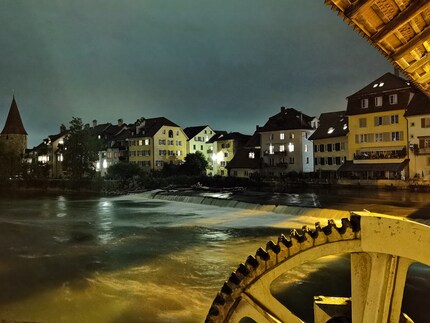
Look at that, the P40 Pro+'s photography is definitely better than its little brother's. I'm talking about the qualitative level, not the aesthetic. The gear details are barely visible on the P40 Pro, but very clear on the P40 Pro+. One reason for this may be that the EXIF data for the P40 Pro shows an exposure time of 7.35974 seconds at ISO 100 and 1.58993 seconds at ISO 2500 for the P40 Pro+. The P40 Pro does a better job of capturing water, as there is less digital noise. The lack of detail is also noticeable in the file size. With the same number of pixels, the P40 Pro image is 1051 Kb, compared to 2194 Kb for the P40 Pro Plus.
Both images are suitable for social media, but not good enough for a photo prize. The sky is too grainy in the P40 Pro+'s photo and there's too much soft focus in the P40 Pro's.
The P40 Pro's image is a little too grainy for social media.
If the AI also stopped making the sky always light blue, light grey or light orange at night, I'd probably be a lot happier with the shots. I understand that we have a pretty serious problem with light pollution, but that doesn't necessarily have to be reflected in night photos taken by a smartphone, which are processed by artificial intelligence anyway. After all, the camera sees more than our eyes. The AI isolates the sky quite well, no doubt, but the night filter applied to the raw images is average.
If I quickly apply Photoshop, this is the result:
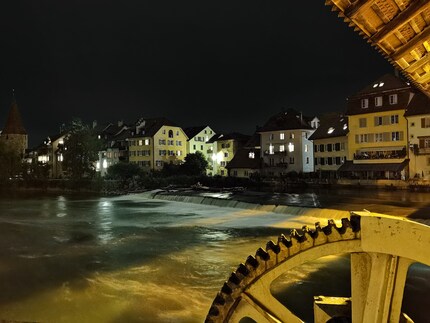
I've only moved the saturation and brightness to around -70. An AI would also manage this with no problem.
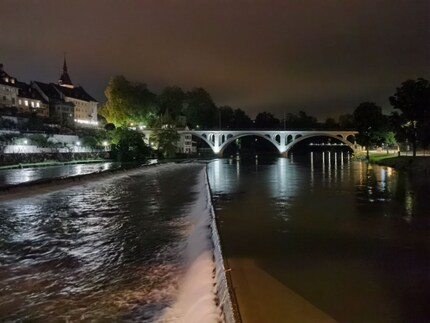
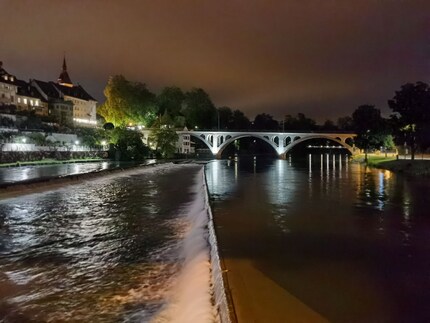
Yes, the P40 Pro+ is brighter. In aperture mode, the two images have exactly the same number of pixels and are almost the same size at 7000kb and 7229kb. The EXIF data shows f/0.95, an exposure time of 1/10 and ISO 3200 for both cameras. The photos were taken at three-minute intervals.
However, the image from the P40 Pro+ is much better, even though the sky is orange due to light pollution. If our eyes were better and could absorb more light, we would see the orange glow in the sky. Just like cats and other nocturnal animals do. Back to the technology: the Pro+ has more detail, more colour and clearer lines. Both are perfectly suited to social media. The Pro+ simply proves that its lenses are in fact superior to the other models.
Note: none of the lenses can reach an aperture of 0.95. The difference between f/1.8 and 0.95 in the final image is calculated by the AI and added to the image in the EXIF data. This works well for me, because I like the 0.95 images much more than the night mode ones. And that's only because night mode generally makes the sky far too bright. This isn't just the case with Huawei, but also with Samsung, Oppo and almost every other manufacturer that offers a night mode.
Night mode is relatively straightforward. For the AI to make decent calculations, it needs a light source in the image that is more than just points of light on the horizon. But it can't be too strong. Strong backlighting gives strange results. Let's see what the "best camera on the market" and the "best camera on the market...more" do.
As a backlight, I simply use the headlights of my car. In theory, the camera should take the headlight as the brightest point and adjust the white balance - called "ISO" in the jargon - accordingly, so that the light isn't just a white area and the background isn't just black. In night mode, the AI does the calculations and tries to do its best for the background. This means that the ISO has to be higher and so the camera runs the risk of the headlights only generating white areas.
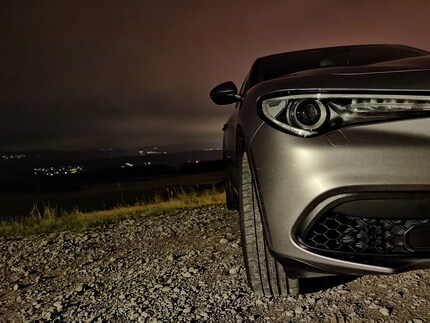
First of all: both phones seem to have made no attempt to improve the background a little. Partly because the Alfa's headlight is powerful and partly because the phone's AI probably thought I wanted to look at the flare factor.
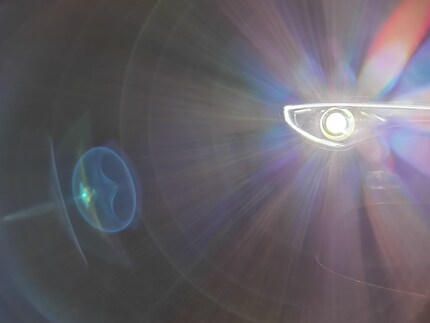

In aperture mode, that's exactly what happens with ISO. The high beam on breaks everything. In night mode, the software recognises the shape of the bulb and even sees the indicator.
It gets really exciting when you add the same shots from the P40 Pro+. The Plus sees red colours in them, while the P40 Pro relies on white and blue tones.
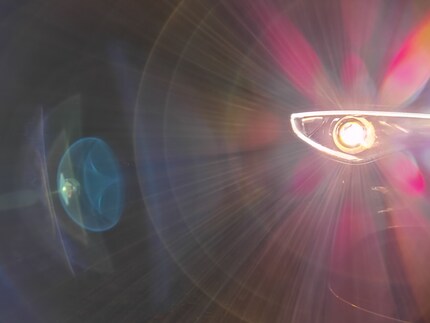

We've produced a flare factor. Time to get some sleep. The times delivered by the EXIF data give is 11:58pm. It's definitely too late...
6 h 52. It's raining. What a shame! With all its resources - optical and digital - the Huawei P40 Pro only offers a 50x zoom. The Pro+ fights Samsung's Space Zoom with 100x.
A quick comment on the weather. Of course, I would have preferred to take the photos in glorious sunshine. Of course, there would be less interference in the air. I informed Mother Nature that I would like to have ideal conditions for the camera, but she was not impressed by this request. So, unfortunately, I have to make do with the weather as it is. Just like the average user has to do. Because this is the situation in which the phone has to prove itself. It's not the optimal conditions that show what a system can do, quite the contrary. And we're here to test, not brag. Real life, no marketing.
On a pontoon in Küssnacht am Rigi, I see mists with dramatic effect. They could just as easily be clouds. As McCoy would say, I'm a journalist, not a meteorologist.

I can only make a direct comparison between the P40 Pro and P40 Pro+ up to 50x, as that's the maximum zoom level the P40 Pro offers. Photos were difficult to take, even with a tripod, as the smartphone oscillates a lot at 50x.

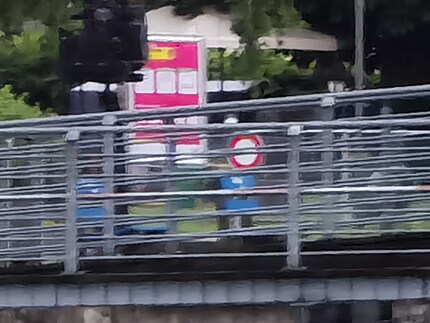
None of the photos are good. The Pro+ sees more of the stronger shadows and assigns black more generously than the P40 Pro, which only sees shades of grey. What's more, the Pro+ sees more detail in the railing. The problem: both images are unusable. This is just a technical demonstration. Nothing more, nothing less.
The P40 Pro+ can zoom up to 100x. This is a hybrid zoom, which mixes optical and digital zoom, then adds a healthy dose of data from the 50MP lens. Only a phone can keep up with this development so far. The Samsung Galaxy S20 Ultra.

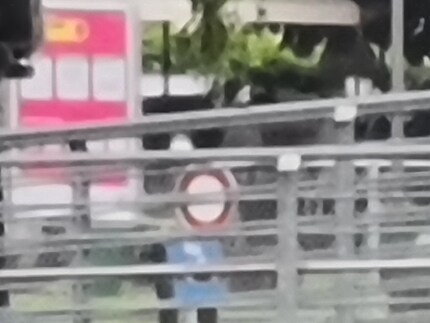
When I say "best" here, I mean "least bad", as neither Samsung's lens nor Huawei's can be described as "good". The P40 Pro+ also sees more detail than the competition at 100x. At this zoom level, the camera itself doesn't recognise much. As a result, it bloats individual pixels, turning the image into a collection of blurry, square patches of colour. To prevent this from happening, the phones' AI tries to recognise the contours and blurs them out. Then the colours are corrected according to the best analysis methods and in the end an image like the one above is created.
Samsung's main problem isn't even necessarily edge recognition, but colour correction. If Samsung were a little more aggressive with colour correction, the result wouldn't even be that bad compared to Huawei.
The main problem is not even necessarily edge recognition, but colour correction.
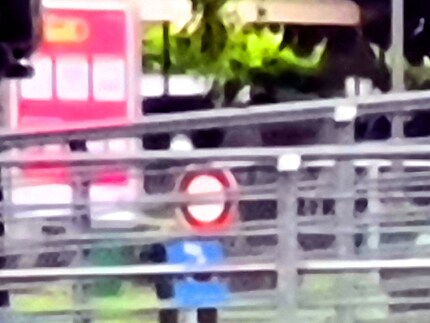
For this image, I adjusted two things. I corrected the black level. The black under the branch and the white at the front of the railing. Then I set the colour saturation to +65. The colour information is there, but Samsung's AI is a little too conservative. The image information for contours is missing. The smartphone cameras, at both Huawei and Samsung, don't see far enough to be able to output a really useful image.
A quick note about the video: I wanted to know if the interaction between the AI and the camera microphone is as bad on the Huawei P40 Pro+ as it is on the P40 Pro. So, I take duct tape, a motorbike, up and down a hill at 80 km/h.
In fact, the result should be the same as with the P40 Pro: I accelerate, the engine becomes noisier, the AI defines it as background noise and abruptly filters it out. On the hardware side, the microphones are identical. But on the software side, there is a difference.
This is probably due to the fact that the software on the P40 Pro+ is more recent than that on the P40 Pro. Please note: the version of the software installed on the Plus is not commercial. Nevertheless, it does seem that the wind is filtered better and the engine noise is suppressed less.
On the other hand, when it comes to image stabilisation, the non-'Plus' P40 Pro seems to be better. With the Plus, I see a lot of very small jolts in the image and the promised fluid camera movement isn't there.
The differences between the Huawei P40 Pro and the Huawei P40 Pro+ are minimal. Both on the technical sheet and in terms of use. And they're certainly not worth 400 francs. 100 francs perhaps, but paying a random sum for minor improvements seems presumptuous to me. If there were to be more one day, probably on the software side, it would make more sense to release the phone at the same time as the software. So I'm looking at a device with a ceramic back that raises more questions than it answers.
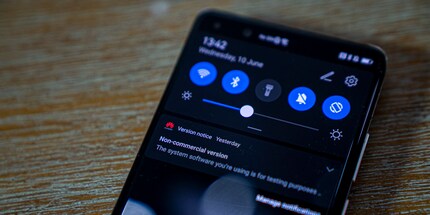
Both cameras do a very good job of providing usable images, even if the AI aesthetics need to be questioned. The night sky is not light grey, light blue or light orange. However, the technological performance of both models is currently leading the market. The Pro+ is even ahead.
For Huawei, diluting its portfolio wasn't worth it. Today, the P40 Pro is no longer cutting-edge, but neither is it a standard release. It lacks a clear role, a concrete function. Yes, the P40 Pro+ is better, but it's simply too expensive for that little extra. My suggestion: scrap the Pro+ idea again and keep what we have today as the P40 Pro+ for the P50 generation as the Pro version. What's wrong with that? The portfolio becomes slim and understandable again. As a journalist, I'm missing out on a good test, but, in return, I'll sleep more.
So, on its own, is the P40 Pro+ any good? Yes. Are the photos great? Absolutely. Is it worth an extra 400 francs and the destruction of a clear portfolio? No.
That's it, I'm done. Incidentally, the P40 Pro+'s ceramic back is, colour-wise, a long way behind the P40 Pro's Silver Frost. Both in colour and haptics.
Journalist. Author. Hacker. A storyteller searching for boundaries, secrets and taboos – putting the world to paper. Not because I can but because I can’t not.